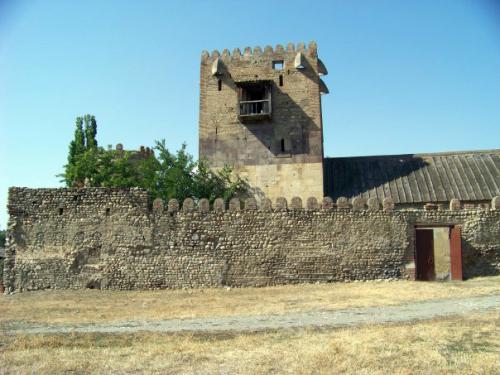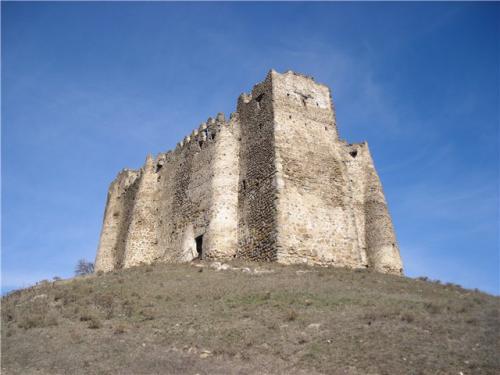
By Aleko Tskitishvili
Wine tourism in Georgia would flourish if the government’s one of the top priorities is to restore and administer those historic and architectural monuments, where traditional Georgian maranis are preserved. At the same time, additional research has to be done in order to designate hundreds of national buildings as historic-cultural monuments. Unfortunately, these valuable historic resources are ignored nowadays and many unique buildings are being destroyed right before our eyes.
It’s worth noting that according to the order issued in 2012 by the Minister of Culture and Monument Protection of Georgia, qvevri (the unique and ancient winemaking clay vessel in which wine had been fermented and stored in villages and towns throughout Georgia for ages) was designated as a significant intangible cultural heritage. The same status was granted to qvevri according to No 91 order of February 8, 2012 issued by the President, not to mention last year’s historic decision made by UNESCO. Still, no further steps have been taken by the Ministry of Culture and Monument Protection since this legislative breakthrough. Indeed, the ancient qvevris carrying the status of a significant intangible cultural heritage, are preserved in those historic cellars most of which are very damaged and are going to be demolished in several years due to the neglect and improper care.
Several monuments of Kartli region, described in the book, 'The Description of Historic and Cultural Monuments of Georgia' (volume 5), demonstrate the facts well on this matter.
The house of the Eristavi noble family, for example, represents an architectural monument and is preserved in the village of Didi Mejvrsikhevi of Gori municipality. The original building of the house dates back to the 17-18th centuries, later, specifically in the 19th century, it was rebuilt. The house was reconstructed several times. One can now enter its marani (the size of 10.4 X 15,5m) through its entrance hall. The marani has an arched entrance and two windows on opposite sides. There are rectangular and arched niches of different sizes on the walls. Several niches serve as embrasures, which suggests that this part of the building originally had agricultural and defensive purposes. The cellar is divided into two sections by the octahedron brick columns. Along the columns, there are round-angled pilasters on the east, south and north walls. The western part of marani is also divided into two parts by the two brick columns that create an arch. There is a Satsnakheli winepress placed across the west blank wall of marani. The cellar has a wooden crossbeam roof.
There is another significant architectural monument in Didi Mejvrsikhevi – the castle of Mirmanoz Eristavi. This is a complex consisting of a fortress and a palace. There are three distinguished periods of its construction: 1. The fence and the gateway of fortress as well as the cylindrical towers were built in the 17-18th centuries. 2. In the middle of the 18th century, they built a two-story palace into the south wall of the gate from the courtyard side of the fortress. 3. At the end of the 18th century and the begining of the 19th century, Mirmanoz Eristavi, (the father of Manana Orbeliani), expanded and rebuilt his castle.
The book doesn't describe its marani. However, there is a basement mentioned where they could arrange a wine cellar or 'Enoteca.'

There are other interesting cultural, historic and architectural monuments in Didi Mejvriskhevi. If they are restored and renovated, the village will turn into an exciting cultural and touristic oasis.
The complex of the Orbeliani Palace in the village of Lamiskana of Gori municipality, represents one more interesting example of architectural and historic monuments. The fortress itself was built in the 18th century. In the 19th century, as they were building the palace, the south wall of the fortress gate was used as one of the walls of the palace. That is why the upper part of the gate – a row of embrasures, is deconstructed to the level of a military trail. The palace was built by Ivane Orbeliani on the land that was given to his wife, Nino Eristavi, as a dowry by her father, Tornike Eristavi. Thus, the palace is named after Orbeliani. In the 19th century, Alexander Orbeliani and Mariam Jambakur-Orbeliani were the last owners of the complex. The literary salon of the Orbeliani family used to unite famous Georgian figures including Ivane Javakhishvili, who was married to Mariam Orbeliani's niece, Anastasia Orbeliani. The house also had a rich family library of the Orbeliani dynasty.
The castle of Amilakhvari in the village of Kvemochala of Kaspi municipality, is a typical example of feudal residences of the 17th and 18th centuries. There is also a Skhvilo Fortress in this village, which historically belonged to the Amilakhvari family. This architectural and historic monument is relatively well preserved and can be restored in accordance with the maximum preservation of its authenticity. It is worth noting that several popular scenes from the movie 'Sherekilebi,' by Eldar Shengelaia, were taken here.
In addition to the government initiatives, private investors and businessmen can also make their contribution to the restoration process of such monumental buildings. Creating a legislative basis, which will allow the use or the conditional ownerships of these monuments, could make this process appealing to these potential contributors. By conditional ownership one means imposing certain conditions on the property owners. One such condition, for example, could be about insuring the availability of the property to tourists so that they're able to visit these sites. If these flexible forms of monument maintenance are not facilitated, the country's government itself will not be able to fulfill the responsibility and take the proper care of thousands of historic monuments, just like it wasn't able to do so during Soviet times.
Recently, some Georgian wine companies have incorporated the term 'Chateau' in their names. The companies spend huge amounts of money to build and promote their so-called Chateaux. However, most of them are teetering on the brink of kitsch having no connection with true French Chateaux. It would be nice if these financial resources are spent on building and renovating historic Georgian maranis, fortresses and residential buildings. There are several good examples of this, for example: the restoration of the House of Mukhranbatoni by Château Mukhrani that took place in the village of Mukhrani and the restoration of Alaverdi Monastery’s historical marani by Badagoni.
There are many residential houses scattered throughout Georgia, which can be renovated through the help of a business sector. Restoring some of these buildings is a great opportunity for the companies to raise their prestige. For example, the government can encourage the Sarajishvili Company to allocate funds and make it interested in renovating one of the residential buildings in the village of Khvedureti of Kareli municipality. This house represents a designated architectural and historic monument. This might be an interesting case for the Sarajishvili Company as Vakhtang Tsitsishvili (the son of David Tsitsishvili), a famous specialist of Georgian brandy, was born in this house. According to the book description, the house had a marani equipped with traditional Georgian qvevris and was built in the 19th century.
I’d like to write about one more interesting residential house that is located to the north of the St. George Church in the village of Arbo of Gori municipality. According to the book description, it was built in the biginning of the 20th century and belonged to the General Ilia Makarashvili. Simon Kldiashvili, the author of the main campus of Tbilisi State University, was the architect of this very house as well. The house still existed in 1990, the year in which the fifth volume of 'The Description of Historic and Cultural Monuments of Georgia' book was published. It had a basement, in the north side of which there was a marani equipped with a Satsnakheli and qvevris. There were beautiful deep arched niches on the walls of the marani. Unfortunately, while I was trying to look for the information about the current condition of this house, I found out that it was completely demolished. Indeed, I think it is important to excavate this place since the underground basement and qvevris may still be preserved.
Many interesting maranis are preserved in Asureti and Bolnisi as well. In the 19th century, Germans settled in these areas and started to practice winemaking and viticulture. Most of their houses have been demolished, only a few of those buildings have been completely preserved. However, the houses that are reconstructed in the places of these demolished ones, still have those underground maranis that have been built by Germans. They are fascinating not only because of their architectural forms, but also because of their quirky functional solutions.
Finally, it is worth noting that the restoration of historic and architectural monuments cannot be brought about only by the Ministry of Culture and Monument Protection. It is necessary to develop special government programs that will effectively manage the restoration works while other ministries of Georgia will be actively involved in the process (For example: Ministry of Regional Development and Infrastructure, National Tourism Administration, National Wine Agency, etc.), also the Holy Synod of the Patriarchate of the Georgian Orthodox Church (since some maranis are located in the territories of their churches), wine companies and the business people from different fields.
© Georgian Wine Club/vinoge.com






